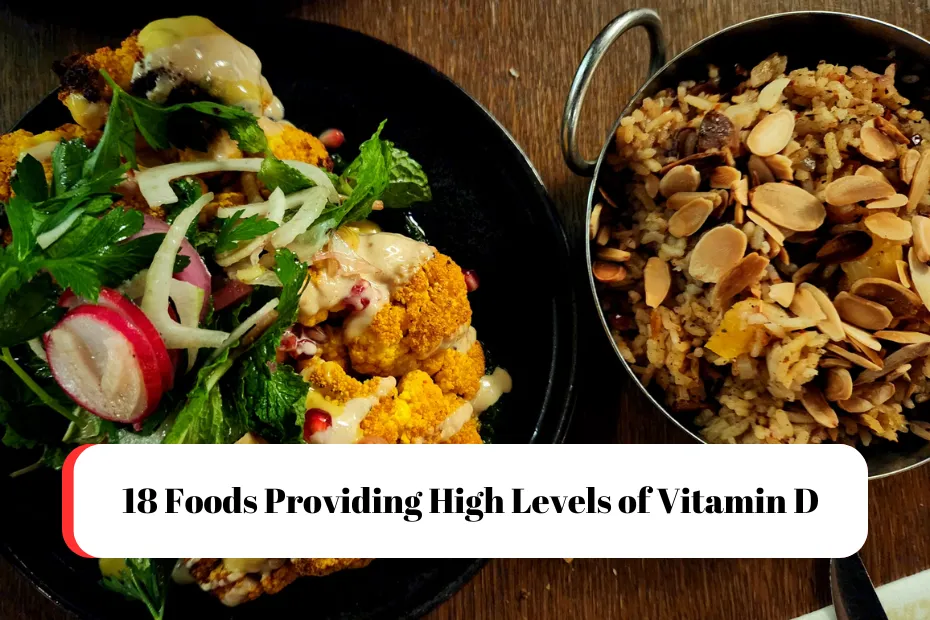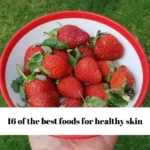Vitamin D is essential for overall health, playing a crucial role in bone strength, immune function, and mood regulation. While sunlight is a primary source of this vital nutrient, many people struggle to get enough due to various lifestyle factors. To help combat vitamin D deficiency, incorporating a diverse range of foods into your diet is key.
In this blog, we explore 18 foods providing high levels of vitamin D, from fatty fish and fortified dairy products to plant-based options. By understanding and including these nutrient-rich foods, you can boost your vitamin D intake, support your health, and enjoy delicious meals.
Green Peas
Green peas are not only a delicious addition to a variety of dishes, but they also provide a surprising source of vitamin D, particularly when fortified. Depending on the brand, some frozen or canned peas can offer around 40 IU per serving. In addition to their vitamin D content, green peas are rich in vitamins A, C, and K, along with dietary fiber and protein.
Their sweet flavor and vibrant color make them an excellent side dish or ingredient in salads, soups, and stir-fries. Incorporating green peas into your meals can contribute to your overall nutrient intake while providing a satisfying, low-calorie option that enhances both flavor and texture.
Shrimp
Shrimp is another seafood option that boasts a notable amount of vitamin D, offering approximately 152 IU per 3-ounce serving. In addition to being low in calories and high in protein, shrimp is also a good source of selenium, vitamin B12, and omega-3 fatty acids. The versatility of shrimp allows for a wide range of cooking methods, including grilling, sautéing, or adding them to pasta dishes and salads.
When purchasing shrimp, opting for wild-caught varieties can provide the added benefit of higher omega-3 levels. Incorporating shrimp into your diet not only helps boost your vitamin D intake but also adds a delicious seafood option to your meals.
Fortified Plant-Based Milks
Fortified plant-based milks, such as almond, soy, and oat milk, have become increasingly popular, especially among those following vegan or lactose-free diets. Many brands fortify their products with approximately 100–140 IU of vitamin D per cup, making them a valuable source for individuals who do not consume dairy.
These plant-based options also offer additional nutrients, such as calcium and vitamin E, which can further enhance bone health and support overall nutrition. Using fortified plant milks in smoothies, cereals, or cooking can help you reach your daily vitamin D requirements while accommodating dietary preferences.
Barley
Barley is a nutritious whole grain that, when fortified, can provide a decent amount of vitamin D. A serving of fortified barley may contain around 40 IU. Besides its vitamin D content, barley is rich in fiber, which supports digestive health, and various essential nutrients such as B vitamins and magnesium.
It can be used in soups, salads, and side dishes, adding a hearty texture and nutty flavor. Incorporating barley into your diet not only boosts your vitamin D intake but also contributes to overall health by promoting satiety and providing long-lasting energy.
Avocado
While avocados are not typically known for their vitamin D content, some fortified varieties do exist. A serving of fortified avocado may contain around 40 IU of vitamin D, making it a tasty way to boost your intake. Beyond vitamin D, avocados are rich in healthy fats, particularly monounsaturated fats, which are beneficial for heart health.
They also provide fiber, potassium, and vitamins C, E, and K. Their creamy texture and mild flavor make avocados a versatile ingredient in salads, smoothies, or as a spread on toast. Incorporating fortified avocados into your meals can enhance nutrient density while offering delicious taste and health benefits.
Riced Cauliflower
Riced cauliflower is a popular low-carb alternative to traditional rice and can also be fortified with vitamin D. A serving of fortified riced cauliflower may contain about 20–30 IU. This vegetable is low in calories and high in fiber, making it an excellent choice for those looking to maintain a healthy weight.
It is also rich in antioxidants and vitamins C and K. Riced cauliflower can be easily incorporated into various dishes, such as stir-fries, grain bowls, and casseroles, providing a nutritious base while increasing your vitamin D intake. This versatile ingredient is perfect for those aiming to diversify their meals without sacrificing health benefits.
Fatty Fish
Fatty fish, such as salmon, mackerel, and sardines, are among the richest dietary sources of vitamin D. A serving of cooked salmon can provide up to 570 IU (International Units) of vitamin D, which is more than the daily recommended intake for most adults. These fish are also an excellent source of omega-3 fatty acids, which have been shown to support heart health, reduce inflammation, and improve brain function.
The combination of vitamin D and omega-3s makes fatty fish a powerhouse food that can contribute significantly to overall health. Including fatty fish in your diet two to three times a week can help ensure you’re getting sufficient vitamin D, along with other essential nutrients.
Cod Liver Oil
Cod liver oil is another exceptional source of vitamin D, with just one tablespoon providing around 1,360 IU. Historically used for its health benefits, cod liver oil is rich in both vitamins D and A, as well as omega-3 fatty acids. Its potent nutrient profile makes it an ideal supplement for those who may have difficulty getting enough vitamin D through diet alone. While some may find the taste unpalatable, there are flavored versions available on the market.
Additionally, incorporating cod liver oil into your routine can support bone health, boost the immune system, and may even play a role in mood regulation. It’s essential to consult with a healthcare provider before starting any supplementation to determine the appropriate dosage.
Fortified Foods
Many foods are fortified with vitamin D to help combat deficiencies, especially in populations at risk. Common fortified foods include dairy products like milk, yogurt, and cheese, as well as plant-based alternatives such as almond milk and soy milk. A cup of fortified milk typically contains about 120 IU of vitamin D. Breakfast cereals and orange juice are also frequently fortified, making it easier for individuals to increase their intake without changing their diet significantly.
Fortified foods are especially beneficial for those with dietary restrictions or limited sun exposure, ensuring that essential nutrients are still accessible. When choosing fortified options, it’s important to read labels to ensure you’re getting the correct amounts of vitamin D.
Egg Yolks
Eggs are a versatile food that provides several nutrients, with egg yolks being particularly high in vitamin D. One large egg yolk contains approximately 37 IU of vitamin D. While this amount may seem modest, eggs are an easy and affordable way to incorporate vitamin D into your diet. They also offer high-quality protein and are rich in essential amino acids, making them a great addition to meals.
The nutrients found in egg yolks can contribute to improved brain health and eye health, along with promoting a feeling of fullness, which may aid in weight management. Including eggs in your breakfast or as a snack can be a simple yet effective way to boost your vitamin D levels.
Beef Liver
Beef liver is often overlooked but is one of the most nutrient-dense foods available. A 3-ounce serving of cooked beef liver contains around 42 IU of vitamin D, along with a host of other nutrients like iron, vitamin A, and B vitamins. While not everyone enjoys the taste or texture of liver, it can be prepared in various ways, such as pâtés or blended into meat dishes.
Consuming beef liver can have numerous health benefits, including improved energy levels and enhanced cognitive function. It’s also a great option for those looking to increase their iron intake, making it a particularly beneficial choice for individuals with anemia or those needing to support their blood health.
Cheese
Cheese, especially certain types, can also be a source of vitamin D. For example, Swiss cheese contains approximately 6 IU of vitamin D per ounce. While cheese may not provide high levels compared to fatty fish or fortified products, it is a delicious way to add some vitamin D to your diet. Cheese is also a good source of calcium, which works synergistically with vitamin D to promote bone health.
Including a variety of cheeses in your meals, such as adding them to salads, sandwiches, or as a snack, can enhance flavor and contribute to overall nutrient intake. It’s important to be mindful of portion sizes due to the higher calorie and fat content in many cheeses.
Mushrooms
Mushrooms are the only plant-based source of vitamin D, making them an excellent option for vegetarians and vegans. When exposed to ultraviolet (UV) light, mushrooms can produce significant amounts of vitamin D2. Varieties like shiitake and maitake can provide up to 1,000 IU of vitamin D per serving when exposed to UV light.
Incorporating mushrooms into your diet can add a unique flavor and texture to dishes, from stir-fries to soups and salads. They also offer other health benefits, such as being low in calories and high in antioxidants. For those looking to increase their vitamin D intake through plant sources, mushrooms are a flavorful and nutritious choice.
Fortified Orange Juice
Fortified orange juice is a popular breakfast beverage that can also serve as a source of vitamin D. Many brands fortify their orange juice with around 100 IU of vitamin D per serving, making it an easy way to boost daily intake. In addition to vitamin D, orange juice is rich in vitamin C and potassium, providing a refreshing and nutritious option.
While fresh-squeezed orange juice offers health benefits, fortified varieties can help individuals meet their vitamin D needs, especially during winter months when sunlight exposure is limited. However, it’s important to consume orange juice in moderation due to its sugar content and calories.
Tofu
Tofu is a fantastic plant-based protein source that can be fortified with vitamin D, making it a versatile option for vegans and vegetarians. A 3.5-ounce serving of fortified tofu can contain around 120 IU of vitamin D, depending on the brand. Besides its vitamin D content, tofu is an excellent source of calcium, iron, and magnesium.
Its ability to absorb flavors makes it a suitable ingredient in a variety of dishes, from stir-fries to soups and salads. Incorporating tofu into your meals not only boosts vitamin D levels but also contributes to a well-rounded nutrient profile, supporting overall health and wellness.
Cereal
Breakfast cereals are frequently fortified with vitamins and minerals, including vitamin D. A serving of fortified cereal can provide about 40–100 IU of vitamin D, depending on the brand. This makes it a convenient option for those looking to increase their intake in a quick and easy manner. Pairing fortified cereal with milk or yogurt can enhance its vitamin D content further.
Additionally, many cereals are also high in fiber, promoting digestive health and aiding in satiety. When selecting cereals, it’s important to choose options that are low in added sugars and high in whole grains to maximize health benefits.
Oysters
Oysters are another excellent source of vitamin D, providing about 320 IU per 3-ounce serving. They are also rich in zinc, iron, and omega-3 fatty acids, making them a nutrient-dense option. Oysters can be enjoyed raw on the half shell, grilled, or included in various cooked dishes.
While they may not be a common part of everyone’s diet, incorporating oysters can provide unique flavors and textures along with significant health benefits. They are particularly known for their ability to support immune function and overall vitality, making them an excellent addition to a balanced diet.
Canned Tuna
Canned tuna is a convenient and affordable source of vitamin D, providing approximately 154 IU per 3-ounce serving. It’s a versatile ingredient that can be used in salads, sandwiches, and casseroles, making it easy to add to your meals. Beyond vitamin D, canned tuna is also rich in protein and omega-3 fatty acids, contributing to heart and brain health.
However, it’s important to monitor intake due to potential mercury levels in certain types of tuna. Opting for light tuna or incorporating a variety of seafood into your diet can help mitigate this risk while still reaping the benefits of vitamin D.
Conclusion
Incorporating foods high in vitamin D into your diet is a simple yet effective way to maintain optimal health. From fatty fish to fortified products, there are plenty of options to suit different tastes and dietary preferences.
By making these foods a regular part of your meals, you can help prevent deficiency and support vital bodily functions. Start exploring these 18 foods today and enjoy the health benefits they bring!
FAQs
1. What are the best food sources of vitamin D?
The best food sources of vitamin D include fatty fish (like salmon and mackerel), cod liver oil, fortified dairy products, and mushrooms exposed to UV light.
2. How much vitamin D do I need daily?
Most adults need about 600 to 800 IU (International Units) of vitamin D per day, but individual needs may vary based on age, health conditions, and lifestyle factors.




